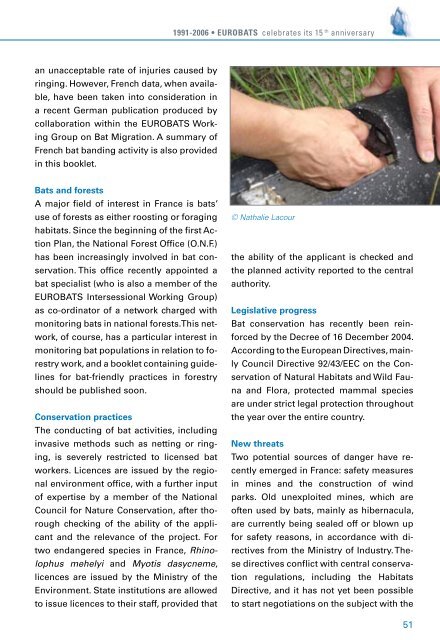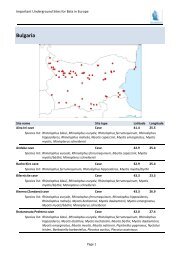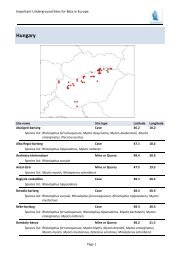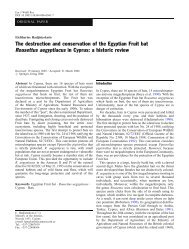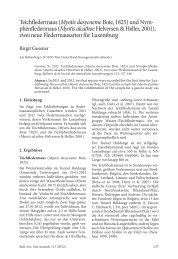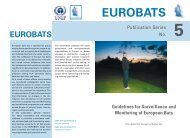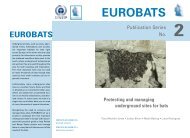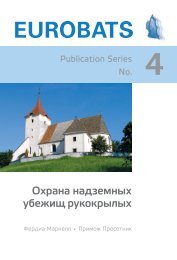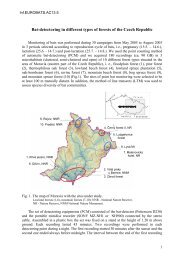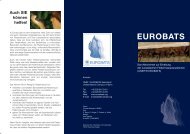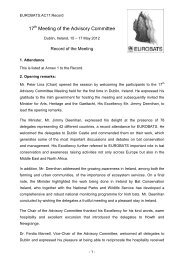1991 - 2006. EUROBATS celebrates its 15th anniversary
1991 - 2006. EUROBATS celebrates its 15th anniversary
1991 - 2006. EUROBATS celebrates its 15th anniversary
Create successful ePaper yourself
Turn your PDF publications into a flip-book with our unique Google optimized e-Paper software.
an unacceptable rate of injuries caused by<br />
ringing. However, French data, when availa-<br />
ble, have been taken into consideration in<br />
a recent German publication produced by<br />
collaboration within the <strong>EUROBATS</strong> Working<br />
Group on Bat Migration. A summary of<br />
French bat banding activity is also provided<br />
in this booklet.<br />
Bats and forests<br />
A major field of interest in France is bats’<br />
use of forests as either roosting or foraging<br />
habitats. Since the beginning of the first Action<br />
Plan, the National Forest Office (O.N.F.)<br />
has been increasingly involved in bat conservation.<br />
This office recently appointed a<br />
bat specialist (who is also a member of the<br />
<strong>EUROBATS</strong> Intersessional Working Group)<br />
as co-ordinator of a network charged with<br />
monitoring bats in national forests. This network,<br />
of course, has a particular interest in<br />
monitoring bat populations in relation to forestry<br />
work, and a booklet containing guidelines<br />
for bat-friendly practices in forestry<br />
should be published soon.<br />
Conservation practices<br />
The conducting of bat activities, including<br />
invasive methods such as netting or ringing,<br />
is severely restricted to licensed bat<br />
workers. Licences are issued by the regional<br />
environment office, with a further input<br />
of expertise by a member of the National<br />
Council for Nature Conservation, after thorough<br />
checking of the ability of the applicant<br />
and the relevance of the project. For<br />
two endangered species in France, Rhinolophus<br />
mehelyi and Myotis dasycneme,<br />
licences are issued by the Ministry of the<br />
Environment. State institutions are allowed<br />
to issue licences to their staff, provided that<br />
<strong>1991</strong>-2006 • <strong>EUROBATS</strong> <strong>celebrates</strong> <strong>its</strong> 15 th <strong>anniversary</strong><br />
© Nathalie Lacour<br />
the ability of the applicant is checked and<br />
the planned activity reported to the central<br />
authority.<br />
Legislative progress<br />
Bat conservation has recently been reinforced<br />
by the Decree of 16 December 2004.<br />
According to the European Directives, mainly<br />
Council Directive 92/43/EEC on the Conservation<br />
of Natural Habitats and Wild Fauna<br />
and Flora, protected mammal species<br />
are under strict legal protection throughout<br />
the year over the entire country.<br />
New threats<br />
Two potential sources of danger have recently<br />
emerged in France: safety measures<br />
in mines and the construction of wind<br />
parks. Old unexploited mines, which are<br />
often used by bats, mainly as hibernacula,<br />
are currently being sealed off or blown up<br />
for safety reasons, in accordance with directives<br />
from the Ministry of Industry. These<br />
directives conflict with central conservation<br />
regulations, including the Habitats<br />
Directive, and it has not yet been possible<br />
to start negotiations on the subject with the<br />
1


